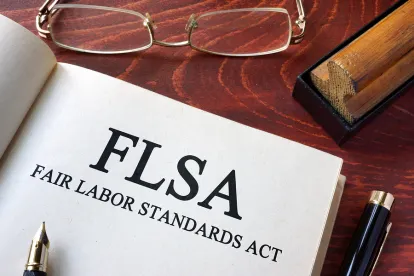The U.S. Department of Labor (DOL) has released its Final Rule updating regulations governing “joint employer” status under the Fair Labor Standards Act (FLSA). The regulations have not been updated in more than 60 years.
Following the Notice of Proposed Rulemaking (NPRM) issued by the DOL in April 2019, the new regulations seek to provide a more uniform interpretation that gives employers greater certainty, as well as to reiterate the DOL’s “longstanding position that a business model — such as the franchise model — does not itself indicate joint employer status under the FLSA.” The new test focuses on whether the purported joint employer “exercises substantial control over the terms and conditions of the employee’s work.” The Final Rule abandons prior interpretations that subjected employers to the risk of being liable as joint employers if they were “not completely disassociated” from a worker.
Four Primary (Non-Exclusive) Factors
Derived from the decision of the U.S. Court of Appeals for the Ninth Circuit in Bonnette v. California Health & Welfare Agency, 704 F.2d 1465 (9th Cir. 1983), the DOL has adopted a four-factor balancing test assessing whether the purported joint employer:
-
Hires or fires the employee;
-
Supervises and controls the employee’s work schedules or conditions of employment;
-
Determines the employee’s rate and method of payment; and
-
Maintains the employee’s employment records.
In the NPRM, the DOL noted that four other circuit courts of appeal have adopted tests that are similar to the Bonnette test. While the DOL acknowledges in the Final Rule that some federal circuits have adopted a different joint employer analysis, it adds that it “has previously promulgated interpretive guidance regarding joint employer liability that overtly conflicts with the approach taken in a particular federal circuit[] … [a]nd given the divergent views of joint employment in the circuit courts, it would not be possible to provide detailed guidance that is consistent with all of them.” The DOL also points out that these circuit court opinions, at least in part, have been based on a “broad” interpretation of the FLSA that calls for a “narrow construction” of exemptions to the FLSA. It notes that this view was abrogated by the U.S. Supreme Court in 2018 in favor of a “fair reading” of the FLSA, “neither narrow nor broad.”
The Final Rule clarifies that not all four factors must be satisfied and that “[n]o single factor is dispositive in determining joint employer status, and the appropriate weight to give each factor will vary depending on the circumstances.” It also emphasizes that “additional factors may be considered, but only if they are indicia of whether the potential joint employer exercises significant control over the terms and conditions of the employee’s work.”
The Final Rule provides that neither “standard contractual language reserving a right to act” nor maintenance of employment records, in and of themselves, will demonstrate joint employer status. With respect to the latter, the Final Rule defines “employment records” as those, “such as payroll records, that reflect, relate to, or otherwise record information pertaining to the first three factors (i.e., hiring or firing, supervision and control of the work schedules or conditions of employment, or determining the rate and method of payment”).
Actual, Not Theoretical, Exercise of Control Required
The Final Rule states:
[T]o be a joint employer under the Act, the other person must actually exercise – directly or indirectly – one or more of the four control factors. The other person’s ability, power, or reserved right to act in relation to the employee may be relevant for determining joint employer status, but such ability, power, or right alone does not demonstrate joint employer status without some actual exercise of control.
In the way, the DOL walked back the position it proposed in the NPRM (that the reserved right to act was wholly irrelevant for determining joint employer status). It concluded “that the reserved right to act can play some role in determining joint employer status, though there still must be some actual exercise of control.” For example, the Final Rule notes:
[I]f a potential joint employer sets the wage rate for an employee and sets his or her weekly work schedule, and there was also evidence that this entity has authority to fire the employee at any time, then this reserved power would be relevant to the analysis and could properly be considered.
Furthermore, the Final Rule provides that “indirect control” is demonstrated by “mandatory directions to another employer that directly controls the employee.” On the other hand, “the direct employer’s voluntary decision to grant the potential joint employer’s request, recommendation, or suggestion does not constitute indirect control that may demonstrate joint employer status. Acts that incidentally impact the employee also do not indicate joint employer status.” The Final Rule states, “For example, a restaurant could request lower fees from its cleaning contractor, which if agreed to, could impact the wages of the cleaning contractor’s employees. But this request would not constitute an exercise of indirect control over the employee’s rate of payment because the cleaning service has discretion to lower its employees’ wages or not.”
Economic Dependence Irrelevant
Unlike the reserved right to act, however, which the DOL concedes may have some relevance, an employee’s economic dependence on a potential joint employer is irrelevant. Such dependence comes into play in determining whether an individual qualifies as an “employee,” but whether that individual is jointly employed is a separate analysis under the FLSA. Therefore, economic-dependence-based factors, such as whether the employee is in a specialty job or one requiring special skill, initiative, judgment, or foresight; whether the employee has the opportunity for profit or loss based on his or her skill; whether the employee invests in equipment, materials or helpers to do the work; or the number of other, similar contractual relationships the potential joint employer has, are not relevant.
Some Business Models and Practices Considered “Neutral”
Expanding on those mentioned in the NPRM, the Final Rule identifies a number of business models, business practices, and contractual agreements that are considered to be neutral in their existence. That is, they do not, in and of themselves, make a finding of joint employer liability either more or less likely. These include:
-
Operating as a franchisor;
-
Operating under a “brand and supply business model,” i.e., where “one business agrees to sell another business’ products under that business’ brand name and comply with certain brand standards and signage requirements, without agreeing to limitations or requirements for other products or services offered;”
-
Contractual provisions “intended to encourage legal compliance or promote desired societal effects,” such as provisions requiring an employer to institute workplace safety practices, sexual harassment policies, wage floors, and morality clauses;
-
“[B]usiness practices where a potential joint employer merely provides or shares resources or benefits with an employer,” such as providing sample handbooks and business forms;
-
Allowing an employer to operate a facility on its premises;
-
Offering an association health or retirement plan to the employer or participating in such a plan with the employer, or jointly participating with an employer in an apprenticeship program — absent evidence that the potential joint employer controlled the use of the resources or benefits by the employer’s employees;
-
Requiring quality control standards and ensuring that the work actually meets the required standards;
-
Indicating or even mandating the time and place of performance of that work that best meets their business needs, unless the potential joint employer “actually acts directly or indirectly to determine how employees’ schedules, routes, or other working conditions will be altered or changed so that the potential joint employer’s time and location needs can be met, rather than leaving such decisions to the employer’s discretion”; and
-
“Suggesting [vs. requiring] methods or providing materials that a franchisee, sub-contractor, or other entity can use to improve their business strategies or profitability.”
To provide additional guidance and clarity, the Final Rule incorporates a number of examples of business and employer-employee relationships to show what does, and does not, create joint employer liability.
Working Separate Jobs, Hours for Multiple Employers
A joint employment relationship may exist where an employee performs distinctly separate jobs for two (or more) different employers and “the employers are sufficiently associated with respect to the employment of the employee.” Under such circumstances, the Final Rule provides, “they are joint employers and must aggregate the hours worked for each for purposes of determining compliance with the [FLSA].” Employers “will generally be ‘sufficiently associated’ if there is ‘an arrangement between them to share the employee’s services;’ ‘[o]ne employer is acting directly or indirectly in the interest of the other employer in relation to the employee;’ or [t]hey share control of the employee, directly or indirectly, by reason of the fact that one employer controls, is controlled by, or is under common control with the other employer.’” A determination of joint employer liability under these circumstances “will depend on all of the facts and circumstances” but “certain business relationships . . . which have little to do with the employment of specific workers [(e.g., sharing a vendor or being co-franchisees)] are alone insufficient to establish that two employers are sufficiently associated to be joint employers.”
What’s Next?
The Final Rule is scheduled to be published in the Federal Register on January 16, 2020, and, barring any legal challenges, will go into effect 60 days later (on March 16, 2020). Whether, and to what extent, the federal courts will defer to the new regulations remains to be seen.




 />i
/>i
